1
Section One: The Fundamentals
A) What do we know about sport? What are common assumptions we make about sport and society?

[type below or paste in a screenshot of your padlet participation]I chose to respond to the point on sports speaking a universal language and my response was:
Yes, I believe anyone who participates in sports themselves or watches it would agree that sports speak a universal language. Regardless of someone’s culture or linguistic ability, people from any background unite over the love and passion that sports have. It not only brings people together but allows people to communicate with one another in a way they may not be able to outside of it, and even on a basic level which creates a sense of community for everyone involved. Many sports also have similar rules and ways to play worldwide, meaning that people can enjoy it regardless of where they live. An example of this is the Olympics where athletes come from nations all around the globe and compete for their countries against one another. These games not only unite the passion amongst individuals but also unify the power of what sports means to them and get everyone at home watching and cheering for their country together.
Reflecting on some comments from my peers, I would say that I agree with many of my peer’s comments, some individuals said no and that is because not everyone plays sports. That is something I disagree with as I feel at some point in everyone’s lives they have played or watched a sport. Whether in school, outside of school, with friends, or even by themselves they have participated in a sports activity as sports are always happening around the world. I also feel that to understand the unity behind sports bringing people and cultures together is something that can be seen without playing it as well.
Exercise 3: Notebook prompt
What are some other metanarratives about sport that you are familiar with? Find an image or video clip or draw something yourself that captures this idea…
So what? Why does any of this matter? Does it matter? As something we grow up with – live with – play through – we don’t often interrogate the meanings of sport, and perhaps we don’t want to.
But being aware of these assumptions and metanarratives is especially important, I would argue, because of the centrality of sport to our everyday lives, the role that sport plays in shaping our childhood and worldviews and….. [finish that thought]

A metanarrative within sports that I am familiar with is “The American Dream” as this is a phrase commonly mentioned within movies and TV shows that display the message of sports, particularly in the United States. Athletes envision a dream where anyone can be successful through hard work and grit regardless of where they come from or their background. Within sports, this can even commonly be referred to as “the underdog story” where athletes or teams who may not be favoured to win, come back and show up to everyone who doubted them by defying the odds against them through perseverance, and resilience. It can even make sports more exciting as it creates more suspense for those watching as it goes against how they thought the results would end.
This matters because these narratives help inspire us, especially at young ages. They help us determine that if we want to achieve something, the only thing in our way is our mind telling us we cannot do it even though in reality we can. These narratives go far beyond sports as well as the American Dream for example can refer to any goal or passion someone has. It just matters that they put in the effort and resilience to accomplish that goal. People do not always associate the meaning behind sports because they are having fun just participating and experiencing it. Sports have a way of bringing people together regardless of what is going on in the world, which is another reason these narratives and assumptions are important to acknowledge.
B) What is social justice?
Exercise 4: Padlet Prompt
Think back to the last section and try to look at some of the ideas we discussed differently. How might sport and social justice actually co-exist?
Record any images, video clips, or gifs you added to the padlet and identify a point of intersection between sport and social justice (can be an issue or a barrier or a debate or something you would like to explore in more depth in this course) . Screenshot or paste in your response below.

 Sports and community justice can co-exist with one another in many different meaningful ways. The first way is community engagement as many sports programs and clubs are held at local community centers, schools, and other buildings that are used by members of the community leading to more opportunities to promote social justice. This can also involve different initiatives to be taken place by different sports teams to be able to foster inclusion and diversity. I reflect on my years of playing hockey and the different community work and local charities we would support and run fundraisers for and I think it is a great way to get underprivileged youth an opportunity for support and care from other members of the community who share similar spaces as them. Another way it can co-exist is through equity representation by being a platform that represents different cultures and genders and even people with disabilities. Having many different representatives within sports is crucial for people watching and not thinking they can participate but then realize they can when they see someone that looks like them playing or advocating in the same sport they wish to play. Intertwining both sports and social justice can lead to a society that is more united and comes together for sports to make sure everyone can be involved regardless of the inequalities that separate them. This can be done by offering financial support programs for those in need, sports that are accessible for everyone regardless of any disability, and lastly, advocates who will represent and make the sports a place for inclusion for all members of the community.
Sports and community justice can co-exist with one another in many different meaningful ways. The first way is community engagement as many sports programs and clubs are held at local community centers, schools, and other buildings that are used by members of the community leading to more opportunities to promote social justice. This can also involve different initiatives to be taken place by different sports teams to be able to foster inclusion and diversity. I reflect on my years of playing hockey and the different community work and local charities we would support and run fundraisers for and I think it is a great way to get underprivileged youth an opportunity for support and care from other members of the community who share similar spaces as them. Another way it can co-exist is through equity representation by being a platform that represents different cultures and genders and even people with disabilities. Having many different representatives within sports is crucial for people watching and not thinking they can participate but then realize they can when they see someone that looks like them playing or advocating in the same sport they wish to play. Intertwining both sports and social justice can lead to a society that is more united and comes together for sports to make sure everyone can be involved regardless of the inequalities that separate them. This can be done by offering financial support programs for those in need, sports that are accessible for everyone regardless of any disability, and lastly, advocates who will represent and make the sports a place for inclusion for all members of the community.
I enjoyed reading what my other classmates had to say throughout their padlet responses as it allowed me to develop new insight to other ways social justice and sports can co-exist outside of my own pre-existing thoughts/feelings. I feel is also important to acknowledge the connection between the two and the many different intersectionalities that exist as well such as equity & representation, advocacy & activism, community engagement, health & well-being, etc.
C) Social Justice Reading
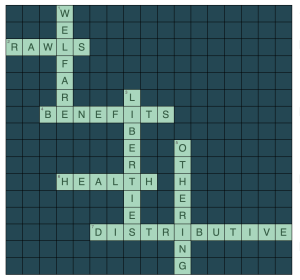
D) KINESIOLOGY AND SOCIAL JUSTICE
Exercise 5:
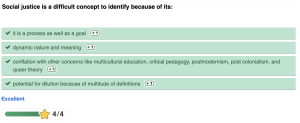



Exercise 6:
What are the implications of bodies-at-risk discourse and the refusal to understand the health gap from a social justice perspective, according to the authors of this article?
Throughout this article, the authors mention how marginalized groups such as women, those with disabilities, people in poverty, and ethnic minority groups are more vulnerable to poorer health outcomes than non-marginalized groups. However, the blame is not focused on barriers such as poverty, discrimination, and other societal impacts affecting marginalized people, but instead on them for their choices that put them in that position. Systematic barriers are in the way of the marginalized groups from being able to receive access to healthcare and other support resources that are needed to build change for themselves and their futures which also limits their ability to get out of these situations as well. Many marginalized groups are blamed for their failure to comply with many health norms are considered to be not only the problem but also the target for solutions as well. Health disparities can affect anyone at any stage in their life, regardless of whether they are marginalized or not. Therefore, it is important through lenses of intersectionality, will be able to tackle the social inequalities and help theorize the voices and experiences of marginalized groups. As mentioned in the article, viewing and valuing stories and perspectives will result in more productive ways to make for a more socially just society.
Section 2: Introducing Sport Feminism
Section Two: Sport Feminism
Exercise 7: Notebook Prompt
What is feminism? What does it mean to you? Choose one of the images below and explain how it captures your understanding of feminism (or find one that does speak to you and paste this into your pressbook with an explanation of why it matters to you.
For 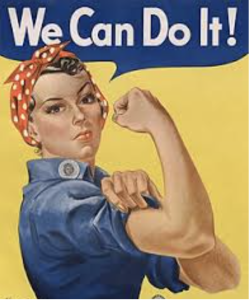 me, feminism challenges the societal norms that have existed for many years that put women at an unequal advantage compared to men. A major part of feminism is advocating for women’s rights in every aspect of life to help address the ongoing issues and eliminate discrimination, workplace equality, reproductive rights, and gender-based violence that they experience daily. In particular, the image I chose was of the woman flexing out her arm with the words “I can do it” behind her. This image stood out to me as there is a stereotype that women cannot do what men can do which is completely inaccurate. Women can in fact do everything that a man can do if allowed to do so. Women are often forced into positions such as caregiving while the men are known to work and provide for the family which not only hides their ability to perform tasks that are considered to be “more manly,” but also segregates them to being considered less “important.” Men are also typically viewed as being more powerful compared to women which can be heavily showcased on television shows as well as movies. For example, When I reflect on my childhood when I would watch Disney movies, the princesses in the films always relied on princes to “save them” which contributes to the narrative that men are the ones who are built stronger because they are the ones going into battle and not the women. The image of the woman flexing her arm signifies that women are just as strong as men and deserve equal rights to showcase their abilities just like men have for centuries. Movies and TV shows in current times are starting to change and display this message more than before which is important for young girls to look up to their favourite characters and feel empowered to be a woman.
me, feminism challenges the societal norms that have existed for many years that put women at an unequal advantage compared to men. A major part of feminism is advocating for women’s rights in every aspect of life to help address the ongoing issues and eliminate discrimination, workplace equality, reproductive rights, and gender-based violence that they experience daily. In particular, the image I chose was of the woman flexing out her arm with the words “I can do it” behind her. This image stood out to me as there is a stereotype that women cannot do what men can do which is completely inaccurate. Women can in fact do everything that a man can do if allowed to do so. Women are often forced into positions such as caregiving while the men are known to work and provide for the family which not only hides their ability to perform tasks that are considered to be “more manly,” but also segregates them to being considered less “important.” Men are also typically viewed as being more powerful compared to women which can be heavily showcased on television shows as well as movies. For example, When I reflect on my childhood when I would watch Disney movies, the princesses in the films always relied on princes to “save them” which contributes to the narrative that men are the ones who are built stronger because they are the ones going into battle and not the women. The image of the woman flexing her arm signifies that women are just as strong as men and deserve equal rights to showcase their abilities just like men have for centuries. Movies and TV shows in current times are starting to change and display this message more than before which is important for young girls to look up to their favourite characters and feel empowered to be a woman.
Exercise 9: Crossword Activity
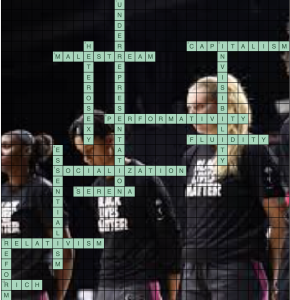
Exercise 10: Padlet Prompt
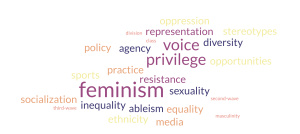
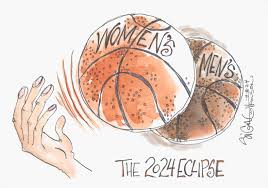
I believe that the landscape of women’s sports is slowly changing for the better. It is getting a lot more attention than before and I think the strong advocation for it the past few years is pushing for real change to be made. However, I feel there is still so much work to be done as male sports still hold such superiority in the sports industry and I do not know if that will ever fully change. When I reflect on women’s hockey for example, there is a women’s league called PWHL which is great as now women have a competitive league, however, is not talked about or broadcasted in the same way as the men’s NHL which is still showcasing how women’s sports are still not considered as important as men’s. I hope that as more representation continues to happen more women’s sports will be televised and promoted as a way to not only support women but also represent the future of sports.

